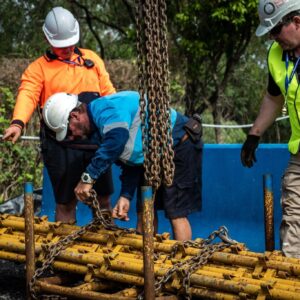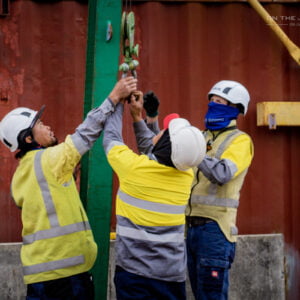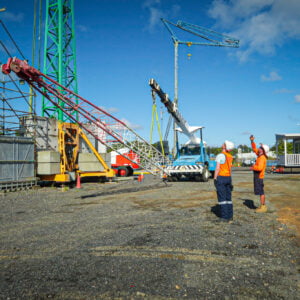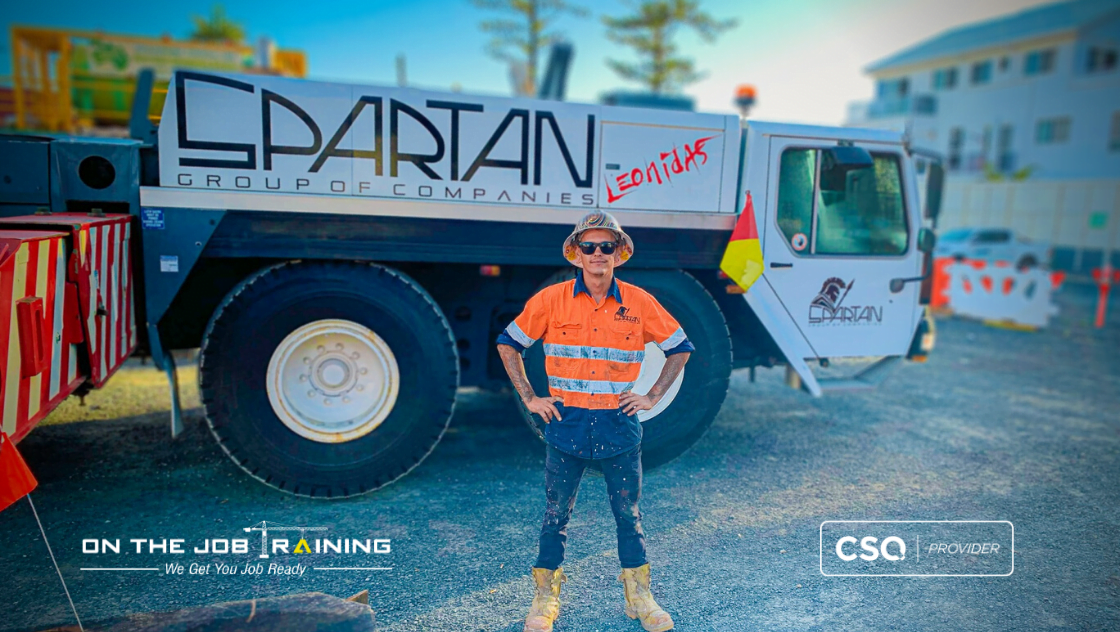BASIC RIGGING COURSE
Courses scheduled weekly with night courses every 6 weeks Course CalendarOnline BookingUnit Name
CPCCLRG3001 – Licence to Perform Rigging Basic Level
Licence
RB
Course Duration
5 Days
Entry Requirement/s
Licence to Perform Dogging (DG)
Course Cost*
Full price: $1990.00
CSQ funded price: $741.00*
Basic Rigging Course
CPCCLRG3001 – Licence to Perform Rigging Basic Level
We are experts in rigging, offering all levels from the basic riggers ticket (RB), intermediate (RI) through to advanced riggers ticket courses (RA). There is a prerequisite for this course to hold a doggers ticket (DG high risk work licence) or have be deemed competent in the CPCCLDG3001 Licence to Perform Dogging unit.
This course is designed to ensure that participants have the skills and knowledge required to perform basic rigging work associated with movement of plant and equipment, steel erections, hoists (including mast climbing hoists), placement of pre-cast concrete, safety nets and static lines, perimeter safety screens and shutters; and cantilever crane loading platforms for licensing purposes.

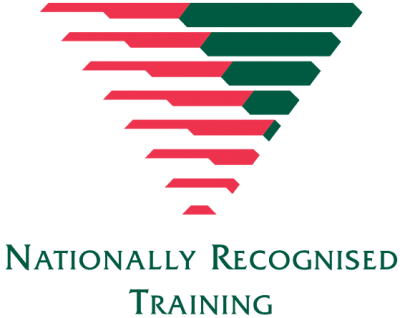
Unit Name
CPCCLRG3001 – Licence to Perform Rigging Basic Level
Licence
RB
Course Duration
5 Days
Entry Requirement/s
Licence to Perform Dogging (DG)
Course Cost*
Full price: $1990.00
CSQ funded price: $741.00*
Basic Rigging Course
CPCCLRG3001 – Licence to Perform Rigging Basic Level
We are experts in rigging, offering all levels from the basic riggers ticket (RB), intermediate (RI) through to advanced riggers ticket courses (RA). There is a prerequisite for this course to hold a doggers ticket (DG high risk work licence) or have be deemed competent in the CPCCLDG3001 Licence to Perform Dogging unit.
This course is designed to ensure that participants have the skills and knowledge required to perform basic rigging work associated with movement of plant and equipment, steel erections, hoists (including mast climbing hoists), placement of pre-cast concrete, safety nets and static lines, perimeter safety screens and shutters; and cantilever crane loading platforms for licensing purposes.
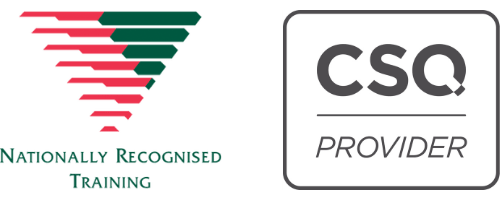
CPCCLRG3001 - Licence to Perform Rigging Basic Level
Basic Rigging Course Overview
This basic riggers ticket course, over 5 days, is designed to ensure that participants have the skills and knowledge required to perform basic rigging work associated with movement of plant and equipment, steel erections, hoists (including mast climbing hoists), placement of pre-cast concrete, safety nets and static lines, perimeter safety screens and shutters; and cantilever crane loading platforms for licensing purposes.
This course requires the applicant to be able plan the work, select and inspect equipment, set up task, erect structures and plant and dismantle structures and plant.
Please note that this course has a pre-requisite requirement that participants hold the unit CPCCLDG3001 - Licence to perform dogging or holding a valid licence for dogging. Participants will have to provide a copy of their Statement of Attainment or their High-Risk licence as evidence.
This course is based upon the National Standard for Licensing Persons Performing High Risk Work.
This course option is suitable for participants without access to a workplace to gain experience, or workplaces who don’t have the resources to supervise staff while gaining nominal hours. If at any time during the course the assessor recognises the need for the participant to complete gap training, participants will be given their logbook to gain nominal hours in the workplace prior to attending an assessment.
On successful completion of this course, participants will be able to apply for a High-Risk Work Rigger Basic Licence. There are costs associated with applying for the licence. Please visit www.worksafe.qld.gov.au for current licence fees.
Application
This unit specifies the skills and knowledge required to safely perform basic rigging work.
Riggers use mechanical load shifting equipment and associated gear to move, place or secure loads, including plant, equipment or members of a structure. Riggers ensure the stability of those members and set up and dismantle hoists.
This unit applies to rigging work involving:
- Structural steel erection
- Hoists
- Pre-cast concrete members of a structure
- Safety nets and static lines
- Mast climbing work platforms
- Perimeter safety screens and shutters
- Cantilevered crane loading platforms.
Rigging work is undertaken in construction and other industries where load shifting equipment is used to move, place or secure loads.
Completion of the general construction induction training program, specified in the Safe Work Australia model Code of Practice: Construction Work, is required by anyone carrying out construction work. Achievement of CPCCWHS1001 - Prepare to work safely in the construction industry meets this requirement.
Competence in this unit does not in itself result in a licence. A licence is obtained after competence is assessed under applicable Commonwealth, state or territory work health and safety (WHS) regulations.
Further Information is available on the following links:
Performance Criteria
- Plan job
- Select and inspect equipment
- Set up task
- Erect structures and plant
- Dismantle structures and plant
Course Outline
- Calculate Safe Working Load (SWL) and Working Load Limit (WLL)
- Ability to erect and dismantle, level, plumb and stabilise associated plant and structures
- Ability to work safely at heights including the correct application of safety equipment
- Accurate interpretation of basic structural charts and structural plans (site information)
- Correct application and use of all rigging and associated equipment
- Risk assessment and hazard control strategies
- Verify problems and equipment faults and demonstrate appropriate response
- Appropriate mathematical procedures for estimation and measurement of loads
- Knowledge of the types and functions of rigging, safety and associated equipment including an understanding of their limitations
- Organisational and workplace standards, requirements, policies and procedures for rigging
- WHS legislation, standards and codes of practice for undertaking rigging activities
- Understanding of inspection and maintenance requirements of a wide range of appropriate plant and equipment in line with Australian Standards or manufacturer's specifications
- Estimation of ground bearing pressures of the full range of soil types and associated ground conditions for setting up plant and equipment
Pre-requisite For This Course
- Participants must hold a current Dogger high risk work licence (DG)
- Provide 100 Points of identification (as per Workplace Health and Safety Queensland requirements)
- Ability to read, write & understand English
What to Bring
- Provide 100 Points of identification (as per Workplace Health and Safety Queensland requirements)
- Steel cap Boots
- Safety gloves
- Hi-Visibility shirt and hard hat with a brim
- Suitable outdoor work clothing (no singlets)
- Lunch and water bottle
- If applicable, any evidence of prior experience e.g old certificates
- USI Number (Find My USI)
Additional Information
Course Timing:Course days typically run from 6:30am to approximately 3:00pm - Participants are advised to arrive 15 minutes early to sign in.
*You may be required to start before 7:00am and stay after 3:30pm depending on how long the formal assessment runs for, we will advise of these times on the day of formal assessment.
Course Structure:
Please note: Competence in a unit does not in itself result in a licence.
Once the trainer believes the participant has demonstrated theoretical and practical understanding of the chosen course (i.e ‘Unit of Competency’), this will be verified with a certificate or what’s known as a ‘Statement of Attainment’ from us, On the Job Training.
They then begin the process of obtaining a licence, via the relevant practical and theoretical assessments or ‘National Assessment Instruments’ (NAI). This is conducted by an assessor on behalf of Workplace Health & Safety Queensland. On successful completion of the mandated assessment, they will be issued with a ‘Candidate Assessment Summary’ (CAS) by On the Job Training.
Upon successful completion of the NAI as stated above, the Office of Industrial Relations Queensland will contact them with instructions on how to apply for the high risk work licence.
For more information about costs associated with the chosen licence visit the Workplace Health & Safety website.
FEATURED CONTENT
Basic Riggers Course - Practical Assessments
Check out a previous Basic Riggers course executing their practical tasks in this cool time lapse video. Erecting steel structures, hoists and precast panels to name a few. Our boom-type EWP features in this clip too, another licence conisdered integral as part of a riggers ticket toolbox.
Tower Crane Dream: How a Bricklayer Became a Dogman
Sometimes you meet that special student, who you can immediately sense as a trainer that they are not only here to learn; they are metaphorically wearing their career goals on their sleeve. Read about Rhea’s inspiring story here.
TESTIMONIALS
Highly Recommended! Very knowledgeable instructors! Very practical course outline. Love the fact that they offer night courses. Will be booking my next course shortly! Thanks guys! Perfect Location too!
I had an absolutely outstanding experience with the entire cew at OTJT.
Very professional and excellent range of experience and skills.
I can reccommend OTJT for having the ability of imparting a great deal of knowledge that will stay with me for the rest of my life. Well done team.
Contact Us
Contact us any time using the details below. Alternatively, leave us a message using the enquiry form we will get back to you the following business day at the latest.
Phone: 07 3807 6061
Email: admin@onthejobtraining.edu.au
Address: 79 Christensen Road, Stapylton QLD 4207
Usual Business Hours: Mon - Fri 6.30AM - 5:00PM


